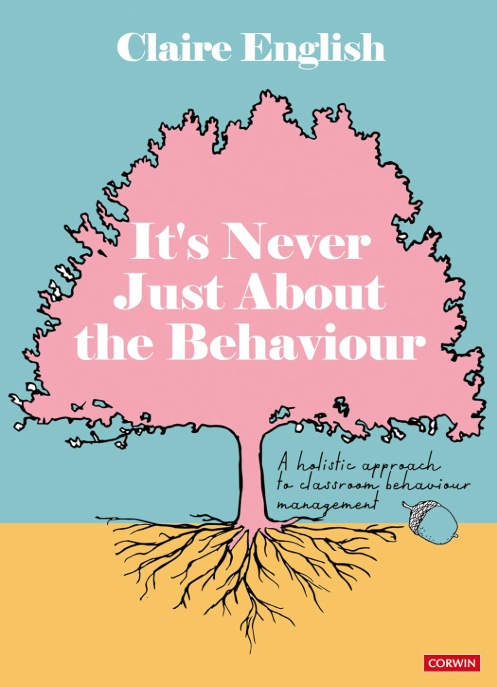
Listen to my interview with Claire English (transcript)
Sponsored by Alpaca and Scholastic Magazines+
This page contains Bookshop.org links. When you make a purchase through these links, Cult of Pedagogy gets a small percentage of the sale at no extra cost to you. What’s the difference between Amazon and Bookshop.org?
The year started off beautifully: You had your routines in place, made your expectations clear, and for a while, your students were behaving just fine. You were teaching right along, getting things done, and then it started to crumble. Little by little, the kids got noisier and more distracted, the classroom started to get chaotic, you found yourself yelling more, running out of time for planned activities, and generally feeling completely run down.
It can happen to the best of us — classroom management deteriorating over time. But don’t despair: By figuring out where the problems are, you can turn things back around.
My guest on the podcast is Claire English, who runs an incredible platform called The Unteachables, where she hosts a podcast, courses, and a membership program all in the service of helping teachers manage their classrooms with confidence and calm. (Learn more about these at the end of the post!)
On top of all that, she published a book this year called It’s Never Just About The Behaviour: A Holistic Approach to Classroom Behaviour Management. I have been bingeing her fantastic content on Instagram for the last year and was thrilled to finally be sitting down with her for a chat.

In the episode, Claire talked about three reasons why classroom management can fall apart midway through a school year, and what teachers can do to get things heading back in the right direction. You can listen to our conversation in the player above, read the full transcript here, or browse the highlights below.
The Big Picture: Your Classroom Management Has Slipped
“I want to start by saying this is so common,” English says. “I think most people can relate to the whole idea of, oh my gosh, I’ve started the year, I’ve gone gung-ho with my expectation-setting and I’ve got this in the bag for the year. But then the consistency starts to slip and as the year goes on, things can get a little bit more challenging. And there are a few things that I always talk about with teachers when this starts to happen.”
Problem Area 1: Inconsistent Reinforcement of Expectations
“Students are constantly pushing boundaries,” English begins. “At the start of the year, they’re like, I don’t really know, miss or sir, like I don’t really know what they’re all about. I’ve heard their expectations, and they sound like they’re serious, but let’s see how this goes. And then as the year goes on, they start pushing and pushing. And if you aren’t meeting them there at that place, and if we’re not reinforcing those expectations, those boundaries in the day-to-day, then things will little by little start to get more difficult to handle as the year goes on.”
Solution: Re-establish your expectations mid-year and start over with fresh consistency.
Full disclosure — I cut Claire off in our conversation before she had a chance to offer a solution (insert cringe emoji here), so I’m making my best guess based on my own experience. There’s no reason why you can’t treat the 65th day of the school year like it’s the first day. Have a quick meeting with students the way you would on day one, explain and establish the expectations, and then move forward with consistency this time. And be prepared to be tested — students will absolutely try to assess whether you actually mean business this time.
[I emailed Claire after publishing this post and she gave my advice the thumbs-up. She added this: “YOU are steering the ship. No matter what things have been like throughout the year, you are in the position to press that reset button and do things differently! This is the process I use to set (and RESET) expectations at any point in the year.]
The next section should help with that.
Problem Area 2: Being Approachable When We Should be Credible
When we engage with our students, we can come across as credible or approachable. Some teachers lean too far in the approachable direction. Learning how to balance the two — when to embody one or the other — can lead to much better classroom management. English learned this concept from nonverbal communication expert Michael Grinder.
“The credible is when we practice more stillness,” she explains. “It’s not about having a sour face on. It’s not about giving the teacher look out over the glasses. Our pace is slower. We’re weighted evenly on both feet. And the message we’re sending when we’re in this teaching presence is I’m serious, and I’m credible, and I mean business, and we’re going to be learning. This is a place of learning.”
The other presence is approachable. “We’re looser, we’re louder, we’re more casual, we’re faster,” English says. “You know, you might get frazzled, you might say things like Come on, guys. You need to be listening.”
Most teachers have a mix of both; getting the balance right is the real trick, and if you’re leaning more toward approachable at times when credible would be more effective, that can create a chaotic environment.
English has observed that some teachers tend to embody the approachable stance too often because they don’t want to sacrifice relationships. “A lot of teachers will say I feel uncomfortable when I’m, you know, trying to be furious in that part of the lesson, and I feel like I want to be a teacher who’s really kind and compassionate, and I want to build good relationships. So I don’t want to tarnish that. But when you are credible, you are not sacrificing the relationship.”
Solution: Start leaning more into the “credible” stance at times when you need students to take you seriously.
“This is not to say that you need to be 100 percent credible and you have to be this strict, stern person,” English says. “It just means knowing this is a tool, this is a strategy, this is being able to be really cognizant of the messages you’re sending through your body language. And your body language is either saying, Now is the time to have a chit chat and relax a little bit or We need to get down to work.”
Problem Area 3: End-of-Term Unraveling
“At the end of the year, things are going to start getting a little bit more challenging,” English says. “And it’s on both sides of the spectrum. There could be a lot of apathy, so you might get less out of some students, you might have them coming to class late. You might hear a lot of, But why are we still doing this? We’ve done our exams. You know, all that kind of stuff. And then you might have real high energy classes. You might have more of the chatty behaviors. You might have students who are just really hard to get on task, really hard to get that buy-in.”
Solution: Stick even more closely to your routine.
“The first thing is just stay super consistent with your routines until the very end. I’m not saying you can’t watch that movie or whatever task you want to do. I’m just saying, the power is in the predictability. They need to be met with something that’s really consistent and predictable because that’s going to help to mitigate the behaviors that you are seeing a rise in, and across the school they’re seeing unpredictability. They might be doing a fun activity here. They might be doing a sports activity there. So if you can be that consistent, predictable island of safety for your students and still have all those lovely routines, then you can break out something in the middle of the lesson and that’s okay. Do a starter. Do what you’ve always done. And then you can kind of swap up the middle.”
Another Solution: Have energy regulation tools on hand.
Because some students will be apathetic while others will have excessive energy, it helps to be equipped with strategies to up-regulate or down-regulate that energy when needed. “You’re going to be reading the room a lot when it comes to the end of the year,” English says. “Things are super unpredictable, the energy’s unpredictable, and it’s all about having some tools at a pinch to help you get to the end of the year.”
For times when apathy kicks in, “I just have a bunch of classroom games,” she says. “Read the room and just know when to throw in a brain break. Know when to go, You know what, everybody? I can see things aren’t going too well. Stand up. We’re going to do a game. Pick a card out of this bunch and let’s choose what game to do together today. So that helps to refocus, but it also gets students up and moving when needed.”
At other times the energy levels need to be brought down. For these moments, English keeps a collection of mindfulness exercises. “So, you know, guided meditation, a bit of chair yoga. Sometimes when students walk in at the end of the year, I’ll have an ambient sound, like a nature sound video going with like a nice, calming video on the background. Just things that I know are going to help.”
A Final Piece of Advice: Be What You Want to See
When asked for a single piece of go-to advice on classroom management, English has an answer ready immediately.
“Be what you want to see from your students. If you see students in front of you that are chaotic, be the opposite. Be the calm presence. Co-regulate with them through that. If you’re seeing that things aren’t going well, What do I want to see from my students? I’m going to embody that. I think of it as us steering the ship of our classroom energetically. Our own regulation is so paramount to everything we do.”
Learn More from Claire
If you love Claire’s approach to classroom management as much as I do, you’ll be happy to know you can get a lot more of it! First, you can listen to her podcast.
Next, you can grab a copy of her book:
Then, check out her courses: That’ll Teach ‘Em and The Low Level Behaviour Bootcamp.


Note: I am an affiliate for the Unteachables Academy.
I receive a commission from every sale that is made through my links.
And finally, if you’re ready to really dive in, consider joining Claire’s membership site, The Behaviour Club, where you’ll find mentorship and training, quality done-for-you resources, and unwavering support to transform your classroom management practice.

Join our mailing list and get weekly tips, tools, and inspiration that will make your teaching more effective and fun. You’ll get access to our members-only library of free downloads, including 20 Ways to Cut Your Grading Time in Half, the e-booklet that has helped thousands of teachers save time on grading. Over 50,000 teachers have already joined—come on in.






I wish it were all this simple. Students are immune to consequences, and parents don’t parent. Add in unsupportive admin and it is a recipe for disaster.
Rosie, classroom management is certainly a complex topic that most, if not all, teachers struggle with from time to time. While this particular post addresses some of the issues that may surface when a well-established classroom management plan goes awry, there is an entire collection of posts on the site related to various aspects of behavior management. I would encourage you to take some time to browse through this collection and see what resonates with you. If you are also open to exploring ways to partner with families to support student success, I’d recommend taking a look at this post on how to involve families authentically.
Your own wellness as an educator can also have a significant impact on the dynamics of your classroom manangement. Two great resources for cultivating your own wellness are this post on building emotional resilience , even in challenging teaching conditions, and this post about altering the way we experience challenges by changing the stories we tell ourselves about teaching. I hope these resources spark some helpful ideas for you.
Being approachable is key. Just because you have been teaching for a long time doesn’t mean you can’t be taught something new. Students are not the same as they were ten years ago. Find what works for your students and be consist.
This was an interesting blog to read as it is currently the second half of the year and I feel this to my core. I always say that the kids are more “comfortable” now and they know how far they can push me. I need to work on being more credible. I feel like I try so hard to be fun and loved that sometimes my classroom management suffers. #UNKTE206 January 29, 2025
Hi Kristan, I hope you found some helpful advice in the post. As Jenn says, “Learning how to balance the two — when to embody one or the other — can lead to much better classroom management.” The good news is once you go too far in the wrong direction, it’s always possible to course correct. Good luck!
This was a helpful listen. At this point in the year, I definitely do feel like my classroom management is hurting. I look forward to trying the “5 seconds of stillness” strategy and integrating the “credible” approach next week with my students.
So glad the episode was helpful for you, Carey! Jenn will be happy to hear that you are planning to give the strategies a try.
I have only been teaching a year and a half … a career switch from International Sales for 30 years to teaching middle school Math. I’ll begin by saying what a relief it was to read that it was very common to see behavior begin to slide downhill as the year progresses. I forget sometimes that these kids will always be pushing the boundaries, and if I let my guard down, they will take the forfeited land promptly.
The common theme I have seen and read through articles, podcasts, and blogs is consistency. The great consistent routines we enforced in the beginning of the year must be enforced throughout … especially just before the holidays, and as the school year winds down.
I also fall into that category where I don’t want to be “the mean teacher”, and many students take advantage of that. I definitely need to find that balance you spoke of. Thanks for the ideas of maintaining behavior … I’ll be back for more advice!
Bill, we’re glad you found some ideas in this post that resonated with you! If you haven’t already, feel free to check out some of the earlier posts on behavior management. You’ll probably find some good stuff there, as well. Wishing you all the best on your teaching journey!
This blog post is a great reminder that classroom management isn’t a “set it and forget it” system—it requires ongoing reinforcement, self-reflection, and adaptability. I really appreciate the idea of treating any day as a reset point and re-establishing expectations mid-year. It’s easy to let consistency slip, but this post highlights how crucial it is to stay firm while maintaining positive relationships with students. The discussion on balancing credibility and approachability also resonated with me. Striking that balance can be tough, especially when we want to be seen as kind and understanding, but credibility does not mean sacrificing relationships—it strengthens them. The end-of-term strategies are also helpful, as energy levels fluctuate wildly. Overall, this post provides practical and realistic advice for teachers who may feel like their classroom management is unraveling.
This is a great reminder how consistency is so important in classroom management. Like many others, I made a switch from the corporate world into teaching recently. I am only in my second year of teaching, so I am still working to find my teaching presence. I find myself, like others, not wanting to be mean to the kids and really have a goal of building relationships with them. They take my kindness for weakness, and they will occasionally run with it. These tips are awesome for someone like myself, and I am looking forward to implementing some of these suggestions in my classroom. This post is reassuring that it is positive to be strict with rules in order to maintain a well-managed classroom, while also being able to build relationships with students.
As a middle school teacher, I know that mid-year classroom chaos all too well. You start the year strong—routines in place, expectations clear—but somehow, things start slipping. Claire English’s insights are such a good reminder that this happens to all of us, and the good news is, we can fix it. I love the idea of treating any day like the first day—just reset, reestablish expectations, and be consistent. Plus, that balance between being approachable and being credible? So important. It’s not about being strict all the time, but about making sure students know you mean business when it counts. This post is a great reminder that classroom management isn’t about having it all together 24/7—it’s about adjusting and keeping things on track.